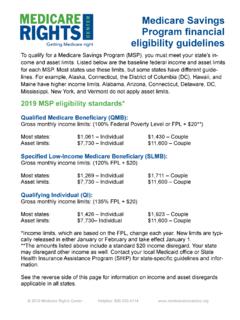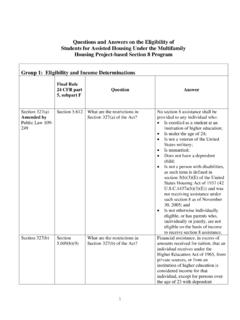Transcription of Medicaid Eligibility and the Treatment of Income and ...
1 Medicaid Eligibility and the Treatment of Income and Assets under the New York State Partnership for Long-Term Care (The only plan covered in this document is the Total Asset 3/6/50 plan). Prepared By: NYS Partnership for Long-Term Care NYS Department of Health One Commerce Plaza, Rm. 1620. Albany, New York 12210. January 2020. DETERMINATION OF Medicaid Eligibility . FOR NYS PARTNERSHIP CONSUMER PARTICIPANTS. REQUIRING NURSING HOME CARE. The New York State Partnership for Long-Term Care (NYS Partnership) has increased public interest in long term care insurance. To understand what the Partnership offers residents of the State and to evaluate whether it is appropriate for you to purchase a NYS Partnership long-term care insurance policy, you must have a basic understanding of how Eligibility for Medicaid for nursing home care is determined, particularly in regard to Treatment of your Income .
2 The Medicaid Eligibility process is demonstrated for you below through a series of Income scenarios which illustrate how certain variables, including marital status and source of Income , affect your Eligibility for Medicaid nursing home care if you purchase a NYS Partnership policy. GENERAL INFORMATION. How the Partnership Works: Medicaid coverage under the NYS Partnership is called Medicaid Extended Coverage. Eligibility for Medicaid Extended Coverage is based upon TIME. Individuals who purchase NYS Partnership policies and subsequently use three (3) years of nursing home benefits (3 years of nursing home days) or its equivalent benefits, six (6) years of home care days (2 home care days counting as 1.)
3 Nursing home day), or some combination of the two which is the equivalent of three (3) years of nursing home days may apply for Medicaid Extended Coverage. Even if benefits remain under a NYS Partnership policy, individuals may still apply for Medicaid Extended Coverage so long as they have used the three years of nursing home equivalent benefits. The NYS Partnership permits a qualified applicant to apply for and receive Medicaid Extended Coverage regardless of the type or amount of resources he or she has. However, all Income . rules in effect at the time of application for Medicaid Extended Coverage will apply in determining one's Eligibility for Medicaid Extended Coverage. Implications of Income Eligibility on Your Decision to Purchase a NYS Partnership Policy: 1.
4 Participation in the NYS Partnership is not for everyone. If you decide to purchase a NYS. Partnership policy, you must support the costs of your long-term care through some combination of the NYS Partnership insurance coverage and out-of-pocket payments for any required co-payment during the period that you are using the required three years of nursing home equivalent benefits. Individuals who are not able to afford the costs of support during this time period without significantly reducing their resources should carefully consider whether purchasing a NYS Partnership policy is appropriate for them. 2. 2. When evaluating whether to purchase a NYS Partnership policy, you must also look at whether you can afford care without depleting your resources.
5 If you can afford care without depleting resources because your Income is sufficient to pay for the costs of your care, the NYS Partnership may not be for you. While you may qualify for Medicaid Extended Coverage without regard to your resources, you still may not qualify for Medicaid Extended Coverage if your Income is too high. The Medicaid Extended Coverage Worksheet set forth below will show how Income affects your Eligibility for Medicaid Extended Coverage. 3. Since you may apply for Medicaid Extended Coverage without regard to your resources, you are exempted from the transfer of resources penalty regulations if you participate in the NYS Partnership. If you participate in the NYS Partnership, you may sell, transfer, or spend your resources, before, during, and after applying for Medicaid Extended Coverage.
6 TERMS AND DEFINITIONS. 1. Maximum Community Spouse Monthly Income Allowance: Under the Medicare Catastrophic Coverage Act of 1988, a monthly maintenance allowance was established for the non- Medicaid spouse who remains at home (community spouse). This amount is adjusted each year. The Monthly Income Allowance for 2020 is $3,216 per month. If the community spouse has Income which is less than the Allowance, Income may be contributed by the nursing home spouse (if available) to bring the community spouse's Income up to the current Allowance. 2. Community Spouse Monthly Income Contribution: Where the community spouse of a Medicaid eligible nursing home resident has monthly Income , which exceeds the Maximum Community Spouse Monthly Income Allowance, he or she is requested to contribute up to 25% of any Income over the current Allowance to the costs of care of the Medicaid eligible nursing home spouse.
7 3. Net Available Monthly Income (NAMI): A patient's NAMI equals his or her Income which is available to offset the cost of care after all deductions have been made. 4. Personal Needs Allowance (PNA): Medicaid recipients in nursing homes are permitted to keep $50 per month from their incomes to pay for personal items. 3. RESOURCES. All or a portion (depending on the policy purchased) of a qualified New York State Partnership for Long-Term Care policyholder's resources are exempt from consideration in determining Medicaid Eligibility . Additionally, since resources are exempt from consideration in determining a qualified policyholder's Medicaid Eligibility , the transfer of resources provision ( , look-back period and penalty period) does not apply.
8 Income produced from a resource can be considered in determining Eligibility for Medicaid Extended Coverage. See Income section below. Income . The information below is an abbreviated overview of individual Income taken into account for Eligibility under Medicaid . For married couples, both incomes are considered when determining Eligibility . Where the Income is distributed jointly to both spouses, it is assumed that each spouse shares an equal interest. Actual Income contributions to the cost of care for the Medicaid eligible spouse, however, depend on the personal Income of each spouse. 1. WHAT IS Income ? Total monthly Income is the gross amount received by the individual or generated by his/her assets.
9 This includes but is not limited to: Pensions Social Security Income from Annuities/IRAs (See 3. ANNUITIES / IRAs: HOW ARE PAYMENTS. TREATED?). Net Income from Rents Interest on Loans and Mortgages Dividends and/or interest from Stocks, Bonds (see exception below), Bank Accounts, CDs, etc., WHETHER OR NOT THE INDIVIDUAL ACTUALLY RECEIVES. THE MONIES. ROLLOVERS AND REINVESTED Income ARE STILL. Income . Capital gain distributions, ( , from mutual funds, other regulated investment companies, or real estate investment trusts), noted on Internal Revenue Form 1099- DIV, Dividends and Distributions, whether paid as cash or reinvested. 4. Some exceptions and items of note: Series E/EE Savings Bonds: Interest is NOT considered Income .
10 I Bonds: Interest is NOT considered Income . Zero Coupon Bonds: Upon maturity, Medicaid considers interest as Income . Capital Gains: Capital gains ( , from the sale of a mutual fund or real estate) are considered an increase in the value of the resource and are exempt under Medicaid Extended Coverage. * Note, however, that capital gain distributions ( , from mutual funds), annotated on Internal Revenue Form 1099-DIV, are considered unearned Income . *Please refer to Section 3, on page v in this document, which addresses how payments from annuities and IRAs are treated. Capital Appreciation: This is NOT considered Income . Life Insurance: Where a person becomes the beneficiary of benefits under a life insurance policy, the moneys are considered Income in the month in which they are received.







